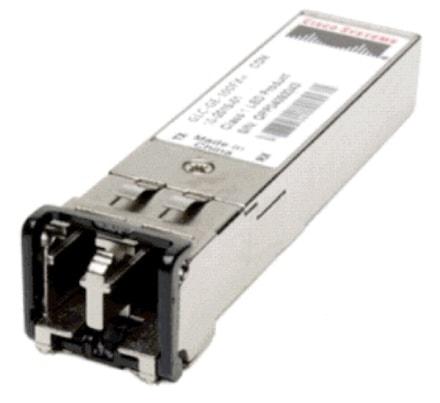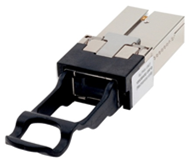Pluggable Optical Modules: Transceivers for the Cisco ONS Family

This document provides technical descriptions, applications, and compatibility information for the following categories of optics modules in the Cisco® ONS product family:
● Gigabit Interface Converter (GBIC)
● Small Form-Factor Pluggable (SFP)
● 10-Gigabit Small Form-Factor Pluggable (XFP)
● 10-Gigabit Enhanced Small Form-Factor Pluggable (SFP+)
● CXP
● C Form-Factor Pluggable (CFP)
● Quad Small Form-Factor Pluggable (QSFP+)
● Cisco CPAK™
● C Form-Factor Pluggable 2 (CFP2)
● C Form-Factor high density pluggable (CXP2)

Cisco offers a comprehensive range of pluggable optical modules for the Cisco ONS family of multiservice platforms. The wide variety of modules gives you flexible and cost-effective options for all types of interfaces. Cisco offers a range of GBIC, SFP, XFP, SFP+, CXP, CFP, Cisco CPAK, and QSFP+ pluggable modules. These small, modular optical interface transceivers offer a convenient and cost-effective solution for an array of applications in the data center, campus, metropolitan-area access and ring network, storage area network, and long-haul network.
SFP module
An SFP transceiver module (Figure 1) is a bidirectional device with a transmitter and receiver in the same physical package. The module interfaces to the network through a connector interface on the electrical ports and through an LC termination connector on the optical ports. Electrical interfaces and dimensions are defined in the SFF-8472 industry-standard Multisource Agreement (MSA).
SFP Transceiver modules for the Cisco ONS Family
XFP module
The XFP transceiver module (Figure 2) is a bidirectional device with a transmitter and receiver in the same physical package. The XFP module contains a 30-pin surface mount connector on the electrical interface and a duplex LC connector on the optical interface.
XFP Transceiver module for the Cisco ONS Family
SFP+ module
An SFP+ transceiver module (Figure 3) is a bidirectional device with a transmitter and receiver in the same physical package. The module interfaces to the network through a connector interface on the electrical ports and through an LC termination connector on the optical ports. It is identical in size to SFP modules, but capable of 10-Gbps transmission.
An SFP+ Transceiver module for the Cisco ONS Family
CXP module
An CXP transceiver module (Figure 4) is a bidirectional device with a transmitter and receiver in the same physical package. The module interfaces to the network through a connector interface on the electrical ports and through a Multifiber Push On (MPO) termination connector on the optical ports. It is dedicated usually for 100-Gbps transmission, and it is only capable of 100GBASE-SR10 connectivity.
A CXP Transceiver module for the Cisco ONS Family
CFP module
A CFP transceiver module (Figure 5) is a bidirectional device with a transmitter and receiver in the same physical package. The module interfaces to the network through a connector interface on the electrical ports and through an MPO or LC connector on the optical ports. The electrical connection of a CFP uses 10×10-Gbps lanes in each direction (receive and transmit), while the optical connection can support both 10×10-Gbps and 4×25-Gbps variants of 100-Gbps interconnects (typically referred to as 100GBASE-SR10 and 100GBASE-LR4 in 10 km reach).
A CFP Transceiver module for the Cisco ONS Family
QSFP+ module
The Cisco 40GBASE QSFP portfolio offers customers a wide variety of high-density and low-power 40 Gigabit Ethernet connectivity options for data center, high-performance computing networks, enterprise core and distribution layers, and service provider applications.
A QSFP+ Transceiver Module for the Cisco ONS Family
Cisco CPAK module
Cisco CPAK 100GBASE fiber modules offer a selection of high-density 100-Gbps connectivity solutions. By using CMOS photonics technology, Cisco CPAK is smaller and consumes significantly less power than alternative form factors (Figure 7). They are fully interoperable with other IEEE-compliant interfaces.
Cisco CPAK module
Cisco 400G CFP2-DCO digital optics
The CFP2 Digital Optical pluggable solution is the combination of the transceiver module and the DSP photonics integrated on a CFP2 form factor. The presence of the DSP module on board distinguishes this CFP2 “Digital” pluggable from the erstwhile CFP2 “Analog” pluggable that is popular in the market today and is also sold by Cisco since a while now.
Cisco 400G CFP2-DCO digital optics
The CFP2 Digital Optical pluggable solution is the combination of the transceiver module and the DSP photonics integrated on a CFP2 form factor. The presence of the DSP module on board distinguishes this CFP2 “Digital” pluggable from the erstwhile CFP2 “Analog” pluggable that is popular in the market today and is also sold by Cisco since a while now.
Digital Optics
Cisco offers a 400G CFP2-DCO pluggable optics module that addresses a wide range of network optical interconnect applications including service provider access aggregation, wireless 5G backhaul, metro and long haul networks, as well as data center interconnects. With support for Ethernet/OTN clients, and line-side transmission of 100Gbps QPSK modulation up to 400Gbps 16QAM, the module offers enhanced flexibility in a pluggable coherent solution. The CFP2-DCO product family features an expansive list of interoperability modes as documented by OpenROADM MSA, and the Optical Internetworking Forum (OIF).
Pluggable solutions such as 400G CFP2-DCO are designed to enable network operators to address increasing bandwidth demand through a pay-as-you-grow model that has the potential of reducing both capital and operational expenditures. The 400G CFP2-DCO module incorporates a 7nm CMOS technology, and a silicon photonic integrated circuit (PIC) for an optimized co-packaged design.
The 400G CFP2-DCO pluggable
The Optical Internetworking Forum (OIF) first created the “400ZR” standard. This 400ZR standard is targeted towards edge and relatively short reach, up to 120km DCI applications. Around the same time, the OpenROADM Multi-Source Agreement (MSA) also defined a specification for a 400G DWDM pluggable, that focused on what service provider networks would need, such as long optical reach (>120km), advanced forward error correction (known as oFEC) and selectable data rates (100G, 200G, 300G, or 400G). Though the additional capabilities were achievable, it would require more power than that specified for the original 400ZR. Therefore, the updated OpenROADM’s specification came to be known as 400ZR+.
Ultimately, between the two organizations and the various optics manufacturers, it was agreed to take the best of the OIF and OpenROADM standards, combine them and call it “OpenZR+”. By combing the features of each in the same form factor, it leaves us with one highly versatile coherent digital DWDM optics. The 400G-CFP2-DCO pluggable offered by Cisco supports all three line protocol modes / standards, the 400ZR, Open ROADM ZR and Open ZR+.
As illustrated in the figure below, OpenZR+ is a combination of two industry standardization efforts created to maintain the simple Ethernet-only host interface of 400ZR while adding support for features such as: (1) higher coding gain using oFEC from the OpenROADM standard, which extends the reach capability; (2) multirate Ethernet, which enables the multiplexing of 100GbE and 200GbE clients over the line-side link, providing optimization options for the switch/router equipment to channelize the traffic over the transport link; (3) adjustable 100G, 200G, 300G, or 400G line-side transport links (using QPSK, 8QAM, or 16QAM modulation), which enables reach/capacity optimization over various fiber links; and (4) higher dispersion tolerance.
Standards: 400ZR, Open ZR and Open ZR+
oFEC is a critical element of openZR+ MSA compliant Digital Coherent Optics. The oFEC engine is a block-based encoder and iterative Soft-Decision (SD) decoder. With 3 SD iterations the Net Coding Gain is 11.1 dB @ BER 10-15 (DP-QPSK) and 11.6 dB @ BER 10-15 (DP-16QAM), with pre-FEC BER threshold of 2.0 × 10-2. The combined latency of the encoder and decoder is less than 3 µs. The higher gain FEC allows OpenZR+ modules to achieve greater reaches and overcome link impairments, such as narrow filtering or dispersion effects, while low latency is beneficial in a variety of access and data center applications. The Cisco 400G-CFP2-DCO leverages this critical aspect by supporting oFEC for Open ZR and Open ZR+ modes and the standard C-FEC in the 400ZR mode.











